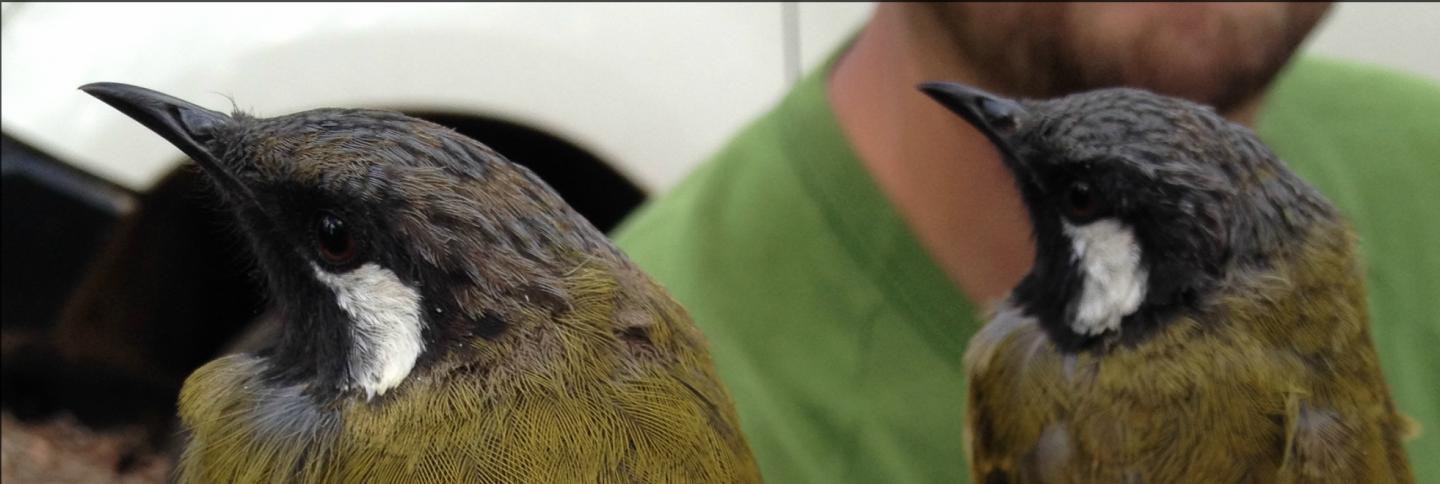
Credit: Photo credit: Nicholas Friedman
During his notable trip to the Galápagos Islands, Charles Darwin collected several mockingbird specimens on different islands in the region. He later discovered that each island only contained a single species of mockingbird and no two species of mockingbird co-existed on an individual island. Due to their geographical separation, over time these birds had evolved different characteristics in coloration, behavior, and beak shape. These observations raise the question: how does a geographical region influence the evolution of a species?
Tropical birds are well known for their colorful appearance: vibrantly colored macaws, parakeets and parrots are widely considered to be the quintessential birds of this region. The popularity of these birds leads many to assume that tropical climates are home to a greater proportion of colorful birds than temperate climates. But do birds evolve to become more colorful when they move to the tropics? Research from Dr. Nicholas Friedman, who is part of the Biodiversity and Biocomplexity Unit at the Okinawa Institute of Science and Technology Graduate University (OIST), helps answer this question.
As part of his research in collaboration with Vladimír Remeš at Palacký University in the Czech Republic, Friedman headed to Australia to examine the feathers of different birds across the country and its neighboring tropical islands to see if there was a correlation between geographical climate zone and color pattern. Australia is home to a rich mixture of species, many of which are found nowhere else. The fact that Australian species were geographically isolated from the rest of the world for so long makes it an excellent place to study evolution. A trip to Australia as a young man contributed to Charles Darwin's pivotal work on evolution, On the Origin of Species.
Friedman began his study at the Australian National Wildlife Collection, where he examined bird specimens from different regions of Australia. A total of 137 different species from two major songbird families were examined. Songbirds originated in Australia nearly 30 million years ago. Research suggests that these birds began diversifying there before colonizing other parts of the world. The familial relationships of the birds that Friedman examined were compared using an evolutionary tree based on the birds' DNA. Friedman then used a special instrument to measure the color of the feathers in particular places on the birds. Birds can see a wider range of colors than humans can, and many are even able to see colors in the UV spectrum in addition to those in the 'visible' spectrum, so the differences in color patterns between birds may appear more pronounced to birds than they appear to humans. Next, Friedman used data from satellites to describe the geographical region each species lives in. He looked at vegetation, precipitation, and humidity of each region, then combined this data with the evolutionary relationships and color measurements of the birds.
The results of this study, published in Global Ecology and Biogeography, show that bird species do not evolve more colorful feathers in the tropics compared to their cousins in temperate climates. "If you look at birds in the tropics, there are a lot of colorful birds that stand out. But there are really more species in general there, and there are just as many more of the little brown ones" describes Friedman. "Instead, birds living in the harsh arid climates of inland Australia tended to have fancier colors than those in the lush tropical islands. Since desert birds have to scramble for mates during the wet season, we think they may be evolving colors that can attract mates quickly".
Meanwhile, birds thriving in climates with more precipitation and vegetation are darker in color overall, while desert birds tend to be lighter. "The pattern is really clear" Friedman reports, "birds living in the desert tend to be more grey on their backs, while birds living in the forest have evolved to be more of a dark green – we think they are evolving these colors to match their background." This would be an example of natural selection, in this case more camouflaged organisms can survive and pass on their genes.
"These results help to explain the origins of the diversity of life, how species end up evolving different characteristics over time", explains Friedman.
###
Media Contact
Kaoru Natori
[email protected]
@oistedu
http://www.oist.jp/





